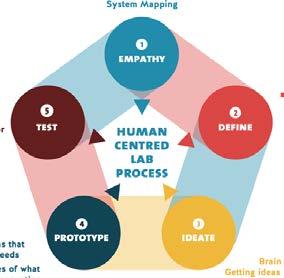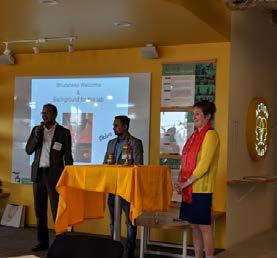
18 minute read
Generating Prototypes: 2 Day Workshop
the opening ofthe lab days
Introduction & Guiding Principles
Shiva and Rohit (Bhutanese community leaders) and Ben (lab facilitator), welcomed everyone and explained what was going to happen over the following 2 days. Shiva and Rohit performed a Bhutanese ceremony that involved lighting a butter lamp and honoring a wise person in the room who was bestowed with the responsibility of protecting the group. The person chosen forthis role was Kate Gunn from City of Edmonton who has been instrumental in pioneering new ways to help address poverty including the co-creation of pathways with community. Shiva and Rohit offered Kate a ceremonial red Katak silk scarfto honor her. Following the ceremony, Ben and Shiva went through the Action Lab Agreement (see below), outlining 10 principles that guided ourwork over the 2 days. These
Kate Gunn, CityofEdmonton, wearing a silk scarf giftedto herbythe Bhutanese community during principles were created in collaboration with the Bhutanese community.

Action lab agreement created in collaboration with the Bhutanese community - 10 principles to guide ourwork overthe 2 days
8
GENERATING PROTOTYPES: 2 DAY WORKSHOP
Learning Station Exploration
To help understand the history, hopes, strengths, and challenges facing the Edmonton Bhutanese community, 4 learning stations were curated by community leaders. The Bhutanese community led a show and share followed by questions and answers to help the lab explorers gain a foundational understanding of Edmonton Bhutanese refugees. After each 12 minute learning round (4 total), people would fill out insight cards and leave them at the stations. This was an amazingly interactive exploration and a highlight ofthe lab days.
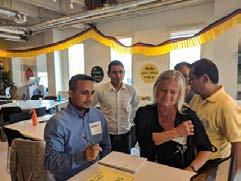

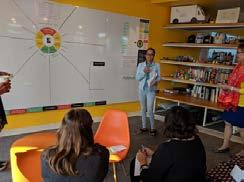
9
Themes that emerged from the learning stations
Three designers attended the lab days to support the group in making sense ofthe insights and ideas generated. The designers pulled key themes emerging from the insight cards filled out by lab explorers at each learning station. These themes were then made into posters (see below) and printed for lab explorers to view on day 2.
BHUTANESE HISTORY
Whatwe learned:
• Bhutan’s location is geographically significant • Bhutan is ethnically diverse • About 6,500 Bhutanese refugees resettled in Canada, and around 300 resettled in Edmonton
Interesting insight:
• An entire generation of Bhutanese people were born and raised in refugee camps
CHALLENGES & OBSTACLES
Whatwe learned:
• It is difficult to gain the first Canadian job experience(s), especially in their chosen field • Bhutanese youth may have difficulty balancing work, school, and the cultural expectation oftaking care of elders • Language and communication is a significant barrier in attaining steadywork
Interesting insights
• It is nearly impossible to get Canadian job experience if all employers require it • Culturally, Bhutanese people may be afraid to take risks and lack confidence • Employer discrimination is a complex and systemic societal issue
10
HOPES &ASPIRATIONS
Whatwe learned:
• Education and skill-building is especially important forwomen, who have traditionally been discriminated against • There is hope for stability - financially, in communities through family reunification, and through permanent residencies
Interesting insights:
• Bhutanese community members have hope for theiryounger,
Canadian-born generations and want to see their children thrive
STRENGTHS & SKILLS
Whatwe learned:
• The skills of Bhutanese people are not seen as transferable by employers • The Bhutanese community seeks harmony in their diversity, and values strong relationships • The Bhutanese are hardworking, respectful, dedicated, resiliant, and ready to help
Interesting insights:
• Youth (20-40 yrs) experience challenges with employment because of low English language and literacy levels • There is a lack of understanding around why jobs are being lost
11
STORIES
Bhutanese community leaders and Multicultural Health Brokers Cooperative worked together to create 3 unique stories that were used as case studies during the lab exploration. The stories were designed to reflect some ofthe common experiences of Bhutanese community members. The purpose ofthese stories was to help lab explorers understand some ofthe challenges, barriers, and strengths of community members experiencing barriers to employment. The three stories and the associated employment pathways are outlined below. Lab explorers were divided into three teams, each exploring a different persona or story.
TSHERING (TEAM 1)
Bhutanese community member needing support with traditional pathways to employment. (e.g. job searching, resume, interview, on the job support)
WANGMO (TEAM 2)
Member ofthe Bhutanese community looking to use their talents and gifts to start a small/home business (e.g. micro enterprise, self employment)
RUDRA (TEAM 2)
Member ofthe Bhutanese community seeking employment but whose main barrierto employment is limited English Language
skills
12
EMPATHY MAPPING
Empathy Mapping was used as a sense making tool during the lab days. This tool is designed to help lab explorers understand an experience from the perspective ofthe user/person. During the lab days the group was split into 3 teams. Each group was assigned one ofthe 3 stories created by the Bhutanese community leaders (outlined above as Tshering, Wangmo, and Rudra). Stories highlighted the hopes, wishes, pain points, and strengths. In addition to the stories, groups also had the opportunity to hear from Bhutanese community members who shared their experiences throughout the activity.
It’s important to note that Empathy Maps represent shared sense making ofthe specific team that came together on the particular day. Empathy maps cannot be used as absolute truths forwhat all members experience. By engaging in Empathy mapping, new insights in a lab team can be generated that can provide insight into the challenge and can help a lab team see innovation opportunities to design solutions around.
Identifying Needs and Areas for Innovation on the EmpathyMaps
After the Empathy Maps, teams did an analysis where they had a conversation and placed 3 color coded tags where the team saw: • 3 Areas for Innovation (I) • 3 Areas of Need (N)
13
Tshering is 28 years old, married, and lives with his parents in Edmonton, Alberta. He was only one year old when his family fled to Nepal. He spent his entire childhood and schooling in a refugee camp in Nepal. Conditions were rough and he and his brothers and sisters were often hungry. But Tshering was one ofthe lucky ones. He was able to complete his high school diploma in the camp just before he moved to Canada under the Government Assisted Refugee (GAR) Program.
He was already 20 years old and his English skills were barely past the beginner stage so he enrolled immediately in the national language program - known as the LINC program - that the Canadian government offers free to all immigrants. But the class was mainly filled with older students - parents and married couples, and the topics theywere studying did not interest Tshering much. Eventually he discovered a college that offered an English program designed especially foryouth. He did very well in that program and graduated with a one year plumbing certificate. He was placed in a work experience job and he hoped theywould hire him as an apprentice. This did not happen. Tshering was disappointed and confused. He thought he had done a good job.
14
He needed to find a job. He was soon to be married and he wanted to move out of his parent’s apartment and have his own home with his wife. A friend told him about an employment support agency for immigrants so made an appointment to get some help writing a resume. He sent the resume to 15 plumbing companies but never got a single reply. He went back to the employment counselor and asked for advice. “No Canadian experience” he was told, “doesn’t look good on a resume”. Maybe you should get a survival job first and work yourway up to a plumbing job. So off he went to get a survival job.
Tshering discovered that the job postings he found in cleaning, or fast food restaurants, orwarehouses didn’t even ask for a resume. They all required an online application. Tshering had a cell phone but could not make the applications work. It was so discouraging. One day a guy he knew told him his data plan was too small and he couldn’t use the app. He then went back to the employment counsellor and, with help, was able to make some applications using the agency computers. This process was taking a lot longerthan Tshering or his family expected. Tshering was feeling badly that he couldn’t earn some money to help his family. And all this running around to apply for jobs was costing a lot in bus fare. Finally, Tshering got his first Canadian job: a part-time, night position stocking shelves in a large grocery store. He was ecstatic. Sure it was minimum wage, but it was a start. And now he would have Canadian experience to add to his resume. His whole family and his new bride celebrated with him. The job did not turn out as he had expected. The supervisors on the night shift were young and inexperienced and really had no control over the workplace. As a new worker, Tshering was ridiculed heavily for his accent, the way he looked, the things he said, the things he knew and didn’t know. He had never been treated so terribly. But the ‘bosses’ were part ofthe problem so he didn’t dare speak up. He was sure he would lose his job, and he couldn’t let that happen. So he said nothing, and kept working.
15
Team 1 Findings (Tshering’s Story) Converge Phase - finding leverage points
N - Needs ofthis User/Person
• Secure employment (eliminating fear of losing job) • Access to information (e.g. about services and programs) • Support and training for inclusive employment (both entry & higher level jobs)
I - Areas for Innovation or Interventions to Improve System
• Advocacy and Mediation (in workplace and out of workplace) • Support and training for gainful, inclusive employment • English program specifically for the workplace
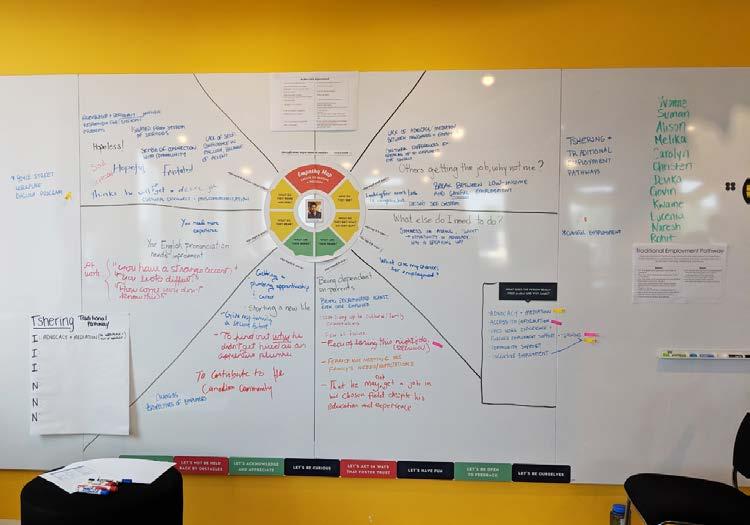
What the team decided on the lab day that this userreally needs and why:
• Advocacy and mediation • Access to information • Paid work experience • Further employment support and training • Community support • Inclusive employment
16
Born and raised in a Bhutanese village, Wangmo was married at the age of 14. She had no formal schooling in her life and instead spent her childhood helping on her family’s farm. In 1992 she and her husband and their two children fled to a refugee camp in Nepal.
While in the refugee camp, Wangmo learned the art ofweaving and spinning wools and was able to make a little money selling her garments. She also tended a small garden and was able to help feed her family with fresh fruits and vegetables during the time of dire food shortages in the refugee camp. She also was able to attend adult literacy classes in the camp and for the first time was able to read and write in her first language, Nepali.
Hoping for a betterfuture, Wangmo and her family resettled in Edmonton as government assisted refugees. At first they accepted government assistance and both attended full time English classes, but eventually they were desperate to make their own way and get off of social assistance, so they set out to find jobs.Someone from the community helped Wangmo find a packaging job which she stayed at for six mo nths before she was laid offfor reasons she does not understand. She continued to apply for jobs on her own but had no success. Her husband works at two part-time jobs and with that the family is able to survive, but just barely. Wangmo has enlivened her passion forvegetable gardening with the support of the Duggan community league. She owns a small community garden and grows spices and vegetables; tending her garden gives her great pleasure. She also enjoys getting togetherwith the women in her community and weaving on a handmade loom. She creates bags and placemats of beautiful colors and textures. One friend has a sewing machine that Wangmo is able to borrow from time to time and she makes a little money sewing for people.
Wangmo is a hard-working and ambitious woman. She is willing to work hard and wants to be self-reliant. She dreams of being able to earn money by selling the food she grows and the clothing and textiles she creates. She knows she needs to have some money to start and a place to sell her goods…but how? Where? She doesn’t know where to begin.
17
Team 2 Findings (Wangmo’s Story) Converge Phase - finding leverage points
N - Needs ofthis User/Person
• Reducing communication barriers • Support system • Capital for start up, space, and operating costs
I - Areas for Innovation or Interventions to Improve System
• Creating a support system • Mentorship • Access to success stories of people in similar situations • More individualised socialaid • Managing acquisition of and confidence in transferable skills • Understanding how to market oneself - considering current market and uniqueness/culture of products
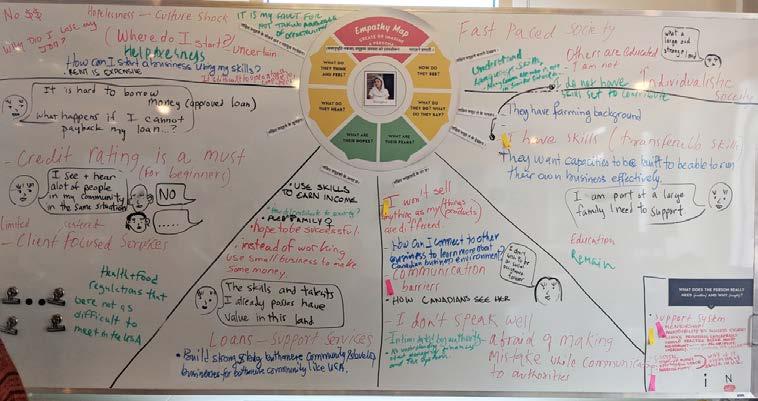
What the team decided on the lab day that this userreally needs and why:
• A support system • Mentorship • Accessibility to success stories • Service providing interpreters • Looking for collaborators • Should practice better need assessment → too prescriptive currently
Capital • Start up money • Affordable space • Advertisement
18
After facing severe persecution in their homeland of Bhutan, Rudra and his wife, Anita, fled to Nepal and spent the next 20 years raising their four children in a refugee camp. They lived in very harsh conditions with minimal food, water, and medical services. Finally, in 2011, they were accepted as Government Assisted Refugees (GARs) to Canada. The first few months in Canada were a “honeymoon stage”. The familywas excited about their new opportunities and happywith their comparative safety and comfort. Rudra rented a small apartment in a neighbourhood with several other Bhutanese families. The proximity offriends and neighbours who spoke Nepali, shared the culture, and understood the experience of refugee camp life was a big support to Rudra and his family. But that sojourn was short-lived.
Lack of affordable housing forced many Bhutanese families to other parts ofthe city and the communitywas dispersed. His inability to speak English meant that Rudra could not find work and poverty became a new threa t. In addition, other realities of being an immigrant with refugee experience – loss of community, disoriented family relations, loss of status, loss of familiar comfort foods and traditions, literacy issues due to interrupted schooling making language learning all the more difficult, and PTSD – took the shine offthe honeymoon glow very quickly. Rudra decided he needed to learn English so he could find a job to support his family. He was grateful that he was able to get into the free English classes offered by the Canadian government, Language Instruction for Newcomers to Canada (LINC). However, Anita, who had even less English than Rudra, could not start her studies right away because there was more than a yearwaitlist for childcare in the LINC program and one oftheir children was still a preschooler.
19
Rudra worked diligently to learn English, but studying was often difficult. The system of schooling was very strange. The alphabet was new to him and since he couldn’t read and write verywell in Hindi, everything about grammarwas totally confusing. He liked the topics they studied: shopping, banking, school system, getting around Edmonton, and finding a job, but there seemed to be so much to learn. Often Rudra found it impossible to focus at school. He frequently felt exhausted and would lose his attention and get lost in worry. He worried about his wife and children and how hard it was for them; he worried about the members of his familywho were still back in the refugee camps. He worried about how he would get enough money to feed his family. Living costs for a family of six were barely covered by the government assistance he was receiving and on top ofthat he has the added pressure of making his monthly payments for the refugee transportation loans for each member of his family. To save on rent costs, Rudra and his family moved into a small house that belonged to another Bhutanese couple. Sharing someone else’s house complicated the family dynamics and added to the stress oftheir lives. After a year and a half, Rudra passed his LINC level 4. He was told that this was a level that would give him enough English to get a job. A counselor at an immigrant serving agency helped him write a resume and although he sent it to many employers, he did not get a single interview. His resume does not impress because it tells only of his experience farming in Nepal.
Eventually a leader in the Bhutanese community linked Rudra to the owner of a grocery store and he got his first job stocking shelves at nightworking at minimum wage. The job only lasted a couple of months before his hours started being reduced until he was barelyworking at all. He never understood the reason his hours were cut.
For several years now, Rudra has had to rely on income support from the government. Meanwhile he continues to study English because he likes to have something productive to do with his time. His speaking is improving but the reading and writing is very frustrating. He has heard about English for Employment programs that can help train immigrants for specific jobs, but he needs to have LINC 6 or 7 for those programs and he can’t progress to the next LINC level until he passes the reading and writing benchmarks. At 45 years old, Rudra is still able-bodied and would much prefer to work and build a solid credit history than to be on government assistance. He struggles with depression. In addition, there are many memories in his past that haunt him. He feels that he is losing hope.
20
Team 3 Findings (Rudra’s Story) Converge Phase - finding leverage points
N - Needs ofthis User/Person
• Get a good job • Build skills (not only language skills but others as well) • Be healthy - both mentally and physically
I - Areas for Innovation or Interventions to Improve System
• Get a good job • Expand/new approach to language learning that is more flexible • Generate incentives to employ refugees/immigrants - (maybe similar to STEP)
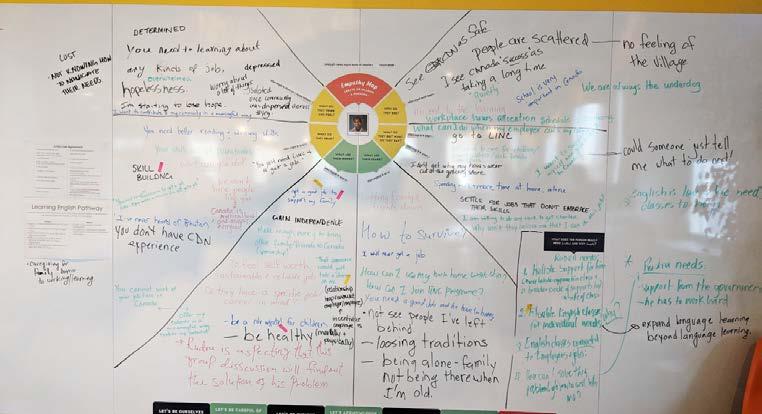
What the team decided on the lab day that this userreally needs and why:
• Holistic support: taking a more holistic approach in class. He also needs a broader circle of supports outside of class. • Flexible English classes that meet individual needs • English classes connected to employers and jobs • Support answering the following question: How can I solve this problem (job) and who will help me?
21
PROTOTYPING
Getting Our Minds ReadyforThinking Differently
On the second day ofthe the lab workshop, we needed to get people’s minds in a space to think differently in order to generate creative employment pathways that work for the Edmonton Bhutanese community. To do this a Bhutanese community leader named Rohit shared a traditional mythological story that highlighted the ways in which many Bhutanese people approach challenges creatively.
The story highlighted key principles ofthinking differently about challenges:

Be open to learn from experienced ones (Gurus) Things on the surface are not always what they seem The need to change perspectives to see a situation from different angles Creativity should be in service to others to alleviate suffering
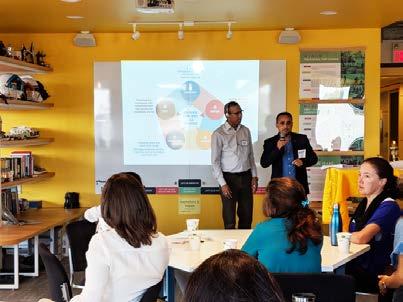
22
Ideating Fresh PossibilitiesToAddressThe Core Challenge
After sense-making of needs through empathy mapping, the teams ideated possibilities through sketching 5 creative possibilities that could meet the needs ofthe people in their case study story. After sketching ideas, the teams gave and received feedback in order to begin to converge on prototype possibilities. To do this teams oftwo created 8 possibilities.

23
A BitAbout Prototyping
After ideation comes prototyping. This is where we make the selected ideas visual, tangible and somewhat testable. Prototyping is a lowcost, low risk way to co-design and test potential solutions. Prototypes are often Storyboards of a service possibility, 3d rough models in Lego describing a concept, visual drawings, service maps, or even role plays. You don’t want to go out and make plans to scale a prototype you have only tested with a few people, with whom the prototype impacts. Testing and pitching the prototypes to more people affected by the prototype can help with checking ifthe prototypes are promising with more people than just the design team. As a side benefit beyond the prototype outcomes, co-designing and prototyping solutions helps to strengthen teams and fosters bridge building.
As lab teams move forward with their prototypes, they need to consider the following to make progress:
1. 2.
3. 4. 5. Is the prototype coherent? Is the prototype likely to be effective in trying to do what it’s supposed to? Is it likely to be feasible? Is it likely to be viable? Is it ultimately testable?
The Prototyping Process
• 6 prototypes emerged during the lab days. Groups connected and continued to refine their prototypes. Groups considered the following as they refined their prototypes. • Discard the prototype: Team decides it’s not worth continuing the prototype pathway • Evolve the prototype: Adapt, Tweak Prototype in some way get more user feedback? • Graduate prototype to Pilot: Team feels positive enough to formally pilot • Go to Scale: Test results and feedback so positive that the team is ready to scale without further testing • Keep Testing prototype: Results oftesting weren’t strong enough to make decisions at this time. Upgrade the evaluation design and try again
The 6 prototypes were refined and collapsed into 3 prototypes Prototypes were furthe r refined during a prototype working night held with community members Prototypes were then made visual with each team creating a poster Prototypes were tested using scrappy testing methods (see key learnings from this in later section)




